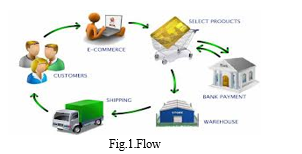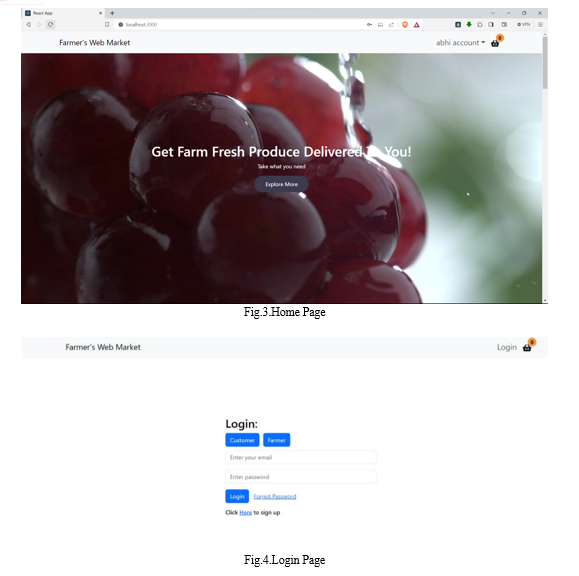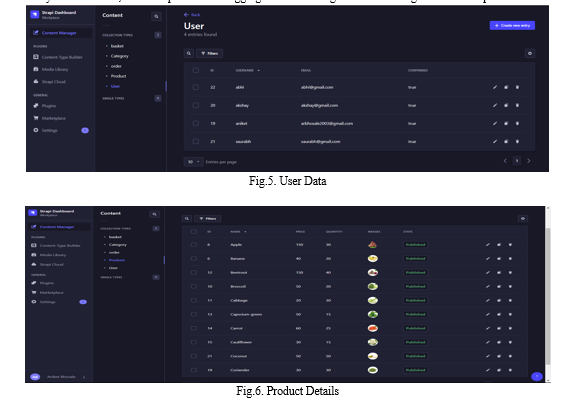Ijraset Journal For Research in Applied Science and Engineering Technology
- Home / Ijraset
- On This Page
- Abstract
- Introduction
- Conclusion
- References
- Copyright
Farm Fresh Products Web Market
Authors: Prof. Sachin C. Rathod, Akshay Kolhe, Aniket Bhosale, Saurabh Bhadre, Shivprasad Helambe
DOI Link: https://doi.org/10.22214/ijraset.2024.60279
Certificate: View Certificate
Abstract
Farmers Web Market represents a transformative approach to the fresh food supply chain, aiming to establish a direct connection between farmers and consumers. Traditional food supply chains often involve multiple intermediaries, leading to increased costs, delays, and a loss of product freshness and quality. In contrast, harnesses the power of technology to streamline the process, enabling farmers to connect directly with consumers, thereby ensuring the availability of high-quality, locally sourced fresh food products. The platform serves as a comprehensive marketplace, providing farmers with a digital platform to showcase their produce and enabling consumers to access a diverse range of fresh food items. Through detailed farmer profiles and product listings, consumers gain insights into the origin, farming practices, certifications, and sustainability initiatives associated with each product, fostering trust and transparency in the supply chain. Farmers have the opportunity to create personalized profiles, where they can showcase their farming practices, certifications, and commitment to sustainability. This transparency allows consumers to make informed decisions about their purchases and supports farmers in building direct relationships with their customers . The platform offers consumers an intuitive interface to browse, search, and filter products based on various criteria such as type, origin, farming practices, and price. Consumers can explore detailed product information, including nutritional values, farming methods, and environmental impact, empowering them to make conscious purchasing decisions. It facilitates direct transactions between farmers and consumers, eliminating the need for intermediaries and ensuring fair prices for both parties. By cutting out unnecessary middlemen, farmers can receive better returns for their produce, while consumers benefit from competitive prices and access to fresher products.
Introduction
I. INTRODUCTION
In the contemporary world, the demand for fresh, healthy, and locally grown food is on the rise. However, the existing food supply chain often proves inefficient and wasteful, with produce covering extensive distances and intermediaries inflating food prices. This project proposes an innovative solution—a platform that directly links farmers with consumers, cutting out unnecessary intermediaries and reducing food waste. The platform aims to create a transparent and efficient marketplace for farmers to sell their produce, providing consumers with access to fresh, locally grown food at competitive prices. Additionally, the project integrates a logistics system to guarantee the timely and efficient delivery of produce from farms to consumers.
The current food supply chain is characterized by long distances between producers and consumers, a complex network of intermediaries, and substantial food waste. These factors contribute to elevated food prices, diminished quality, and environmental degradation. Intermediaries, such as wholesalers and retailers, play a vital role in the current food system, offering essential services like transportation, storage, and marketing. However, these intermediaries also contribute significantly to the cost of food, sometimes accounting for up to 50% of the final price paid by consumers. Food waste is another pressing issue, with up to 40% of all food produced in the United States going to waste.
The proposed platform aims to overcome the challenges of the current food system by establishing a direct connection between farmers and consumers.

This direct link eliminates the need for intermediaries, subsequently reducing costs and food waste. Farmers will be able to create profiles on the platform, showcasing their products for sale. Consumers, on the other hand, can search for products based on location, type of produce, and other criteria, along with the ability to read reviews of farmers and products. The platform will facilitate secure online payments and provide farmers with tools to manage their orders and deliveries.
II. LITERATURE REVIEW
- Online Shopping Behaviour: Factors influencing behavioural intention towards online services. In the context of online shopping, perceived ease of use, time-saving orientation, and privacy and security are identified as critical determinants. The user's perception of the ease of navigating online platforms, the time saved through digital transactions, and concerns related to privacy and security play pivotal roles. Time Saving Orientation (TSO) as a motivation for consumers. The hectic lifestyles of urban dwellers make time-saving a crucial factor, leading them to seek services that streamline the shopping process.
Privacy and Security (PS): Consumers' trust in online platforms is contingent upon the assurance of the privacy and security of their personal information. Addressing these concerns becomes pivotal for the widespread adoption of online services.
2. Online Food Delivery (OFD) Services: Factors Influencing Behavioural Intention in OFD Services: Building on the understanding of online shopping behaviour, the second paper introduces an integrated model for OFD services. It includes factors such as perceived ease of use, time-saving orientation, convenience motivation, and privacy and security as antecedents influencing the behavioural intention towards OFD services among urban dwellers.
III. PROBLEM STATEMENT
In today's fast-paced world, there exists a significant gap between farmers producing fresh food and consumers seeking convenient access to such produce. While the demand for fresh, locally sourced food is increasing, traditional methods of distribution often involve multiple intermediaries, resulting in increased costs, longer delivery times, and reduced freshness. Additionally, consumers are often disconnected from the sources of their food, leading to concerns about sustainability, quality, and transparency in the supply chain.
In this context, there is a pressing need for a streamlined and efficient system that enables farmers to directly connect with consumers, facilitating the seamless ordering and delivery of fresh produce through a website platform. This system should address the following key challenges:
Accessibility and Convenience: Many consumers face challenges in accessing fresh, locally sourced food due to limited availability or inconvenient distribution channels. A website ordering system should provide a user-friendly interface that allows customers to browse, select, and purchase a wide variety of fresh products from nearby farmers with ease.
Transparency and Traceability: There is a growing demand among consumers for transparency in the food supply chain, including information about the origin, production methods, and handling practices of the products they purchase. The website platform should incorporate features that enable farmers to provide detailed information about their products, including certifications, farming practices, and harvest dates, ensuring transparency and building trust with consumers.
Efficiency and Logistics: Traditional distribution channels often involve multiple intermediaries, leading to delays, increased costs, and reduced freshness. A website ordering system should streamline the distribution process, minimizing the number of intermediaries involved and optimizing logistics to ensure prompt delivery of fresh produce from the farm to the customer's doorstep.
Support for Farmers: Small-scale and local farmers often face challenges in reaching a wider customer base and competing with larger, industrialized producers. The website platform should empower farmers by providing them with a digital marketplace to showcase their products, reach new customers, and receive fair compensation for their efforts.
IV. PROPOSED SYSTEM
The proposed system is an online platform that directly connects farmers to consumers, offering transparency, efficiency, and a logistics system for seamless deliveries. The key features of the platform include
- Farmer Profiles : Enables a personal connection between farmers and consumers, fostering trust and transparency.
- Product Listings : Farmers can list their products for sale on the platform with detailed information.
- Online Marketplace : Consumers can easily search for products based on location, type of produce, and other criteria.
- Secure Online Payments : The platform facilitates secure online payment options, ensuring a seamless and trustworthy transaction process.
- Order Management Tools : Farmers are provided with tools to efficiently manage their orders, including the ability to accept or reject orders.
- Logistics System : Incorporates a robust logistics system to ensure timely and efficient delivery of produce from farms to consumers.
V. SYSTEM ARCHITECTURE
The system architecture involves a well-organized structure that encompasses farmer profiles, product listings, an online marketplace, secure online payments, order management tools, and a logistics system. This architecture ensures a seamless and integrated user experience.

VI. FRONTEND
User-Friendly Interface: The frontend design should prioritize simplicity and ease of use to ensure that both farmers and customers can navigate the platform intuitively. Clear navigation menus, search functionality, and intuitive layout are essential for a positive user experience.
Product Showcase: The frontend should prominently feature products with high-quality images, detailed descriptions, and relevant information such as pricing, quantity, and availability. Farmers should have the ability to showcase their produce effectively, highlighting their unique selling points and farming practices.
Customization Options: Provide customers with customization options where applicable, such as selecting the quantity of produce, choosing delivery preferences This enhances the user experience and allows customers to tailor their orders to their preferences.
Responsive Design: Ensure that the frontend is responsive and accessible across various devices and screen sizes, including desktops, laptops, tablets, and smartphones. A mobile-friendly design is crucial as many users may access the platform on their smartphones while on the go.

Secure Checkout Process: Implement a secure and seamless checkout process that trust and confidence in customers. This includes features such as multiple payment options, SSL encryption, and clear instructions guiding users through the checkout steps.
VII. BACKEND
API Integration: Utilize Strapi's built-in REST APIs to fetch data from your backend and display it on the frontend. This involves making HTTP requests to endpoints provided by your Strapi backend to retrieve information such as product listings, user profiles, and order details.
Authentication and Authorization: Implement user authentication and authorization on the frontend to ensure that only authorized users can access certain features or perform specific actions. Strapi provides authentication plugins that you can integrate into your frontend application, allowing users to sign up, log in, and manage their accounts securely.
Dynamic Content Rendering: Use dynamic content rendering techniques to display data fetched from your Strapi backend dynamically. This includes mapping over arrays of products or user profiles to generate dynamic components, and conditionally rendering content based on user authentication status or other factors.
Form Handling: Implement forms on the frontend to allow users to input data such as order details, contact information, or product reviews. Use form handling libraries or frameworks to manage form state, validate user input, and handle form submissions, sending data to your Strapi backend via API requests.
State Management: Use state management libraries or patterns (e.g., Redux, React Context API) to manage application state on the frontend. This includes storing and updating data fetched from the backend, managing user authentication status and session data, and propagating state changes throughout your application.
Routing and Navigation: Set up routing and navigation in your frontend application to facilitate user navigation between different pages or views. Define routes for different sections of your application (e.g., product listings, user profiles, checkout process) and use navigation components or hooks to navigate between them programmatically.
UI Components and Styling: Create reusable UI components and apply styling to your frontend application to ensure consistency and a polished user interface. Use frontend frameworks or component libraries (e.g., React Bootstrap, Material-UI) to build UI components such as buttons, cards, and forms, and apply custom styles or themes to match your branding.
Error Handling and Feedback: Implement error handling and feedback mechanisms to provide a smooth user experience and handle potential errors or edge cases gracefully. Display informative error messages to users in case of validation errors, network issues, or other failures, and provide feedback on form submissions or other user actions.
Optimization and Performance: Optimize your frontend application for performance and efficiency to ensure fast load times and smooth user interactions. This includes techniques such as code splitting, lazy loading, and image optimization to reduce bundle size and minimize loading times, as well as optimizing network requests and API calls for efficiency.
Testing and Debugging: Implement testing and debugging strategies to ensure the reliability and stability of your frontend application. Write unit tests and integration tests for critical components and features, use debugging tools and browser developer tools to identify and fix issues, and incorporate error logging and monitoring to track and diagnose errors in production.

VIII. FUTURE SCOPE
The future of our Farmers Web Market web application holds exciting possibilities. We'll focus on making it even more user-friendly, so everyone, from administrators to farmers, can navigate it easily. For administrators, we'll create tools that provide their product details making their tasks more efficient. Additionally, we'll provide options for customization, so the application can fit the unique needs of each consumers. Expanding the application's reach around the world is on the horizon, which could open up new opportunities for growth. Lastly, we'll focus on scalability to ensure that as more users join, the application remains fast and responsive. These plans will ensure that the web application remains a valuable and adaptable tool for all kinds of farmers and consumers. Expanding the application's reach around the world is on the horizon, which could open up new opportunities for growth.
Developing new features to improve the user experience, such as a recipe sharing platform or a personalized recommendation system. Developing programs and initiatives to support small and independent farmers, such as micro-loans or marketing assistance. Developing programs and initiatives to promote sustainable farming practices, such as organic farming or regenerative agriculture. Educating consumers about the benefits of locally sourced food and sustainable agriculture. Advocating for policy changes that support farmers and sustainable agriculture.
Conclusion
The proposed Farmers Web Market project has the potential to revolutionize the production and consumption of food. By establishing a direct link between farmers and consumers, the project aims to create a more efficient, sustainable, and equitable food system beneficial to both producers and consumers. The project\'s impact on farmers includes increased market access, improved prices, and reduced food waste. Consumers, in turn, gain access to fresh, locally grown food at competitive prices, with the added ability to support local farmers and reduce their environmental impact. The environmental benefits extend to reducing greenhouse gas emissions from transportation and promoting sustainable farming practices. The comprehensive approach of the Farmers Web Market addresses key challenges in the current food supply chain, fostering transparency and efficiency.
References
[1] Z. He, G. Han, T. C. E. Cheng, B. Fan, and J. Dong, ‘‘Evolutionary food quality and location strategies for restaurants in competitive online-tooffline food ordering and delivery markets: An agent-based approach,’’ Int. J. Prod. Econ., vol. 215, pp. 61–72, Sep. 2019. [Online]. Available: https://www.sciencedirect.com/science/article/pii/S0925527318302020 [2] Liu, J., Vethaak, A. D., An, L., Liu, Q., Yang, Y., & Ding, J. (2021). An environmental dilemma for China during the COVID-19 pandemic: The explosion of disposable plastic wastes. Bull. Environ. Contamination Toxicol., 106, 237–240. [3] Supermarket News. Available online: https://www.supermarketnews.com/online-retail/amazon-nearly-double-online-ediblegrocery-sales-2026 (accessed on 25 January 2022). [4] M. R. Arefin, K. M. A. Kabir, M. Jusup, H. Ito, and J. Tanimoto, ‘‘Social efficiency deficit deciphers social dilemmas,’’ Sci. Rep., vol. 10, no. 1, p. 16092, Dec. 2020. [5] Online Food Delivery Platforms and Restaurants’ Interactions Received June 27, 2021, accepted July 3, 2021, date of publication July 7, 2021, date of current version July 13, 2021 [6] Measuring the Service Quality of Fresh Food Delivery Platforms: Development and Validation of the “Food PlatQual” Scale. Sustainability 2022, 14, 5940. https://doi.org/ 10.3390/su14105940 Academic Editor: Stefan Hoffmann Received: 24 March 2022 Accepted: 11 May 2022 Published: 13 May 2022
Copyright
Copyright © 2024 Prof. Sachin C. Rathod, Akshay Kolhe, Aniket Bhosale, Saurabh Bhadre, Shivprasad Helambe. This is an open access article distributed under the Creative Commons Attribution License, which permits unrestricted use, distribution, and reproduction in any medium, provided the original work is properly cited.

Download Paper
Paper Id : IJRASET60279
Publish Date : 2024-04-13
ISSN : 2321-9653
Publisher Name : IJRASET
DOI Link : Click Here
 Submit Paper Online
Submit Paper Online

